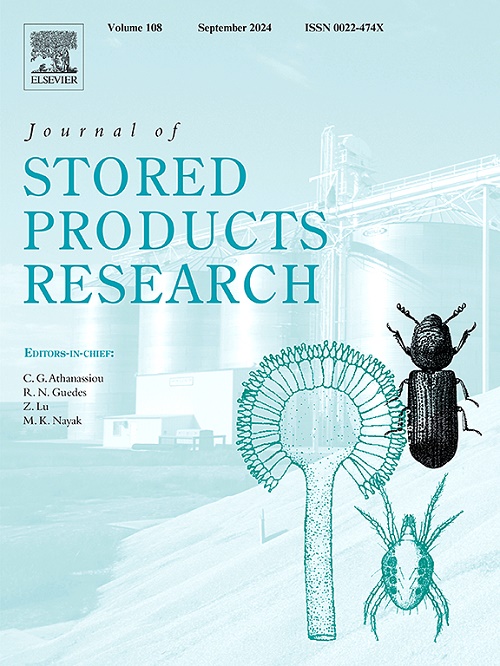松的驱避、拒食和杀虫作用。(松科)提取物对两种储藏产品的昆虫
IF 2.7
2区 农林科学
Q1 ENTOMOLOGY
引用次数: 0
摘要
本研究首次探讨了松木甲醇提取物的毒性、驱避和拒食作用。(松科)对灰蛾(Fabricius, 1792)(鞘翅目:粉蛾科)和castaneum (Herbst, 1797)(鞘翅目:粉蛾科)的叶片。经HPLC-DAD-ESI-MS分析,该提取物的主要成分为牡荆素(21.36%)、千禧年醇(15.11%)和紫丁香苷(9.29%)。不同剂量(19、23.75、47.5和95 mg/mL)的提取液在不同暴露时间(10 min ~ 5 h)对木栗螟的驱避效果分别为50.25 ~ 87.25%和57.25 ~ 93.75%。当最高剂量为95 mg/mL时,对赤霉的驱避作用最强。同样地,对多米尼加白僵虫,在47.5 mg/mL的浓度下,在4 h后达到最大的驱避率,也显示出100%的驱避率。在拒食效果方面,暴露3 d后拒食指数最高。在最高剂量(95 mg/mL)下,该提取物对强阻吓性的多米哥达84%,对中度阻吓性的木栗达57%。不仅如此,该提取物对蓖麻(LD50 = 16.38 mg/mL, LD90 = 47.48 mg/mL)和蓖麻(LD50 = 12.84 mg/mL, LD90 = 31.56 mg/mL)暴露7 d后均有一定的毒性作用。本研究强调了halepensis作为一种强大的驱避剂、拒食剂和毒性剂对这两种害虫的潜力。其广泛的分布和可获得性促进了其作为一种新的植物性杀虫剂作为化学杀虫剂的替代品来控制害虫。本文章由计算机程序翻译,如有差异,请以英文原文为准。
Repellent, antifeedant, and insecticidal effects of Pinus halepensis Mill. (Pinaceae) extract against two stored-product insects
This study aims to investigate, and for the first time, the toxic, repellent, and antifeedant effects of the methanolic extract of Pinus halepensis Mill. (Pinaceae) leaves against Rhyzopertha dominica (Fabricius, 1792) (Coleoptera: Bostrichidae) and Tribolium castaneum (Herbst, 1797) (Coleoptera: Tenebrionidae). The major components of this extract, identified by HPLC-DAD-ESI-MS analysis were vitexin (21.36 %), cirsiliol (15.11 %), and syringetin rutinoside (9.29 %). The different doses of extract (19, 23.75, 47.5 and 95 mg/mL) showed a repellent effect against T. castaneum ranging from 50.25 to 87.25 % and 57.25–93.75 % against R. dominica at different exposure times from 10 min to 5 h of exposure. For T. castaneum, the highest repellency was observed at the highest dose of 95 mg/mL after 5 h of exposure. Similarly, for R. dominica, the greatest repellency was achieved at 47.5 mg/mL after 4 h of exposure, also showing a 100 % repulsion rate. In terms of its antifeedant effect, the highest antifeeding index was observed after 3 days of exposure. At the highest dose (95 mg/mL), the extract reached 84 % for R. dominica, classified as strongly deterrent, and 57 % for T. castaneum, classified as moderately deterrent. Not only that, this extract showed a toxicity against T. castaneum (LD50 = 16.38 mg/mL, LD90 = 47.48 mg/mL) and R. dominica (LD50 = 12.84 mg/mL, LD90 = 31.56 mg/mL) after 7 days of exposure. This study highlights the potential of P. halepensis acting as a strong repellent, antifeedant, and toxic agent against both pests. Its wide distribution and availability promote its use as a novel botanical insecticide to control pests as an alternative to chemical insecticides.
求助全文
通过发布文献求助,成功后即可免费获取论文全文。
去求助
来源期刊
CiteScore
5.70
自引率
18.50%
发文量
112
审稿时长
45 days
期刊介绍:
The Journal of Stored Products Research provides an international medium for the publication of both reviews and original results from laboratory and field studies on the preservation and safety of stored products, notably food stocks, covering storage-related problems from the producer through the supply chain to the consumer. Stored products are characterised by having relatively low moisture content and include raw and semi-processed foods, animal feedstuffs, and a range of other durable items, including materials such as clothing or museum artefacts.

 求助内容:
求助内容: 应助结果提醒方式:
应助结果提醒方式:


